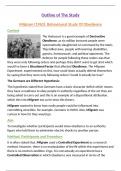Outline of The Study
Milgram (1963): Behavioural Study Of Obedience
Context
The Holocaust is a good example of Destructive
Obedience, as six million innocent people were
systematically slaughtered on command by the Nazis.
They killed Jews, people with learning disabilities,
gypsies, homosexuals, and political opponents. The
defence for people following these orders was that
they were only following orders and perhaps they didn’t want to get shot which
would’ve been a Situational Factor that affected Obedience. The Milgram
Experiment, experimented on this, how could Nazis actually defend themselves
by saying that they were only following orders? Could it actually be true?
The Germans are Different Hypothesis:
This hypothesis stated that Germans have a basic character deficit which means
they have a readiness to obey people in authority regardless of the act they are
being asked to carry out and this is an example of a dispositional attribution,
which ties into Milgram too as he tests this theory.
Milgram wanted to know how easily people could be influenced into
committing atrocities, for example, Germans in WWII. Also, Milgram was
curious in how far they would go.
Aim
To investigate whether participants would show obedience to an authority
figure who told them to administer electric shocks to another person.
Method, Participants and Procedure
It is often stated that, Milgram used a Controlled Experiment as a research
method. However, there is no manipulation of the IV within this experiment and
there is no control condition. Ergo, it is not actually an experiment but a
Controlled Observation in which obedience was measured in terms of the
, voltage given to the learner (This attempts to get a natural reaction but still fails
as we’re not in the participants natural environment).
Milgram used Self-Selected or Volunteer Sampling
with the participants being obtained through
newspaper advertisements and direct mailings.
Volunteers were recruited to investigate ‘memory
and learning’ (which is an Ethical Deception). There
were 40 males who were aged between 20 and 50
whose jobs ranged from a variety of occupations and
backgrounds (unskilled to professional), from New
Haven, Connecticut, USA. Milgram’s study is
Androcentric (meaning only men were involved and
women were excluded. This is bad to Generalise to
the Target Population. But Milgram needed males
because in WW2 they were all male soldiers and Milgram wanted to know why
Nazi soldiers could be so obedient). Participants were paid $4.00 for just turning
up. Plus, 50 cents for carfare.
The study took place in Yale University (A prestigious
university). They used two rooms in the Yale Interaction
Laboratory, one for The Learner (The Confederate) and
another for The Teacher and The Experimenter.
There were three roles The
Learner (Confederate, male, 47, accountant, trained
for the role by Milgram. Real name: Mr Wallace),
The Experimenter (male, 31, stern & emotionless,
biology teacher, who wore a grey lab coat).
At the start of the experiment the participant was
introduced to the other participant (The Confederate). In order to justify the
administration of the electric shock by the participant a cover story was used,
and the participants were told the study was about ‘punishment and learning’.
The participants would then draw paper lots from a hat to see who the teacher
was. The Naïve Participant went first (The Naïve Participant would always draw
the lot ‘teacher’ as the lots were rigged, both slips of paper had ‘teacher’ written
on it). Next The Confederate would then draw the other slip which said




